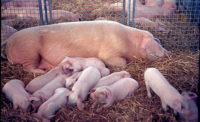What happens when you put food-conscious consumers center stage before a group of food producers?
Oklahoma pork producers had the opportunity to hear straight from the source in a recent consumer panel hosted by The Center for Food Integrity and quickly realized they don’t know as much as they thought about today’s consumer when it comes to thoughts on food and how it’s produced.
“The one word that describes how most of the audience felt about this session is ‘eye-opening,’” said Nikki Snider, director of marketing and promotions with the Oklahoma Pork Council. “Pork producers are busy raising pigs, so they don’t have much time to think about how their products are perceived by those removed from farming.”
And a vast majority is “removed.” In fact, 98 percent of the population has no direct connection to agriculture, which is a reversal from a few decades ago when only two percent of the population was disconnected.
“This panel was a great way to expose them to consumers’ thoughts, myths about farming and how those myths impact buying decisions,” she said.
The GMO conundrum
Panelists were carefully screened by CFI to represent a cross-section of consumers with a heightened interest about food, and questions covered myriad topics. Among those topics covered: the impact of labels on buying decisions, trusted sources, GMOs, the value of purchasing GMO-free foods, what caused their fear of GMOs, and how the food industry can alleviate their fears.
“The term GMO is really meaningless to consumers today,” Snider said. “They simply believe they’re ‘bad.’”
When asked for a definition of GMOs, panelists couldn’t answer, even though all of them indicated they purchase non-GMO foods.
Most of the panelists agreed that there were “a lot” of GMO foods available, with one responding “thousands” and another “millions.” The panelists’ fears with regard to GMOs largely focused on long-term health issues.
Panelists were asked if their opinion about GMOs would change if, for example, they knew the technology could be used to introduce a naturally occurring gene from an arid plant to create corn that could grow using less water — not only resulting in the use of fewer natural resources but allowing corn to grow in drier climates where populations couldn’t grow their own food before.
One panelist replied: “I find it hard to believe that scientists would spend time and money to use the technology to help something grow faster and easier, more than for profit.”
This perception may have developed because early dialogue to consumers about GMOs from the food industry focused on farmer profitability and productivity, without explaining benefits to the environment and ability to raise food in difficult climates.
Lessons learned
While insightful, CFI consumer panels can prove challenging for a room full of people passionate about food production and eager to educate. Once the floor was open to audience questions, producers were instructed to only ask questions of the consumer panelists and not attempt to respond to stated misconceptions or inform them of any such statements. Pork producer Rob Richard was among those in the audience.
“We in agriculture got behind in this new battle for the consumer by assuming, ‘We’re farmers and we produce food, so people love us, right?’” he said. “The good news as I listened to the panel is that they’re open to our story. It’s not too late to turn the tide.”
Other producers lauded the benefits of the panel and course correction in strategic thinking that it provided. Snider is using what she learned to shift her social media and digital advertising approach.
“After the consumer panel, we better understand the urgency of reaching more consumers on topics that matter most to them,” she said. “Consumers want to hear from farmers. We just have to work harder to reach them and engage them where they are — not wait for them to come looking for us.” NP





Report Abusive Comment